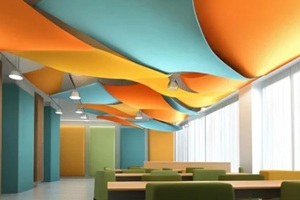 Are you responsible for managing educational spaces, such as classrooms or libraries? Are you a teacher tired of losing your voice when you try to drown out the echoes in your home room? Educational settings can be prone to noise in ways that other spaces are not, and combating that challenge can prove frustrating. Fortunately, many solutions, such as installing acoustic panels for walls or adding a rug, can significantly reduce noise in a room.
Are you responsible for managing educational spaces, such as classrooms or libraries? Are you a teacher tired of losing your voice when you try to drown out the echoes in your home room? Educational settings can be prone to noise in ways that other spaces are not, and combating that challenge can prove frustrating. Fortunately, many solutions, such as installing acoustic panels for walls or adding a rug, can significantly reduce noise in a room.
These elements work best when used together strategically. Each location is different, so the noise-dampening solutions that work for one facility may not be as effective for yours.
Here are the main acoustic options that educational settings and study areas can use to improve the quality of desired noise and minimize echoes and ambient noises that distract from learning experiences.
Flooring
One of the biggest noise carriers in many educational buildings is the floor. If your school is like most, you are dealing with glossy floors that are meant to stand up to foot traffic and the scraping of desk and chair legs, with little thought for their acoustic properties.
However, these strong floors are highly reflective. Sound waves can bounce off freely, reverberating throughout the room and boosting the noise level. Consider whether carpeting is a viable alternative. If it is not, even adding a large area rug on one side of the space can make a difference by reducing the total reflective area.
Ceilings
Like the floors, the ceilings are also flat, making sound reflection easy. Thankfully, ceilings are rarely encumbered by features that prevent the installation of helpful tools, such as acoustic panels. Whether suspended as a drop ceiling or installed as a new type of sound-absorbing tiling, acoustic control in the ceiling eliminates one of the biggest culprits behind loud rooms.
However, it is important to consider how the space is used when choosing a ceiling solution. Suspended panels, for instance, may not be the best choice in a room such as a gymnasium, where stray balls or other items might become lodged on top of the panels.
Walls
 While many classroom walls are partially covered by decorations, student work, bookshelves, and more, their open spaces continue to pose noise challenges in any room. If they are obscured by simple flat objects (e.g., posters on an already flat wall), guests receive little to no protection from excessive echoes, as sound waves continue to bounce around in the room unabated.
While many classroom walls are partially covered by decorations, student work, bookshelves, and more, their open spaces continue to pose noise challenges in any room. If they are obscured by simple flat objects (e.g., posters on an already flat wall), guests receive little to no protection from excessive echoes, as sound waves continue to bounce around in the room unabated.
Acoustic panels for walls are among the most effective ways to improve a room’s auditory environment. As an added benefit, these panels can be fully customized, from their size and thickness to their material and design. Why not turn our educational posters or important information into custom décor that serves both a functional and aesthetic purpose? Print the alphabet on an acoustic panel so you do not have to sacrifice usable wall space to reduce noise in the room.
Additionally, acoustic panels are durable and easy to install. Your classroom will not be out of commission for a week while the noise-dampening solutions are set up. This ease of installation keeps your students on track.
Dividers
In some spaces, such as libraries, using physical dividers can be an effective way to break up noise reflections. Consider study cubicles, privacy panels, or rows of bookshelves to interrupt sound transmission throughout the room.
Addressing Noise at the Source
While any space can be modified to reduce noise transmission, one of the best places to start is at its source. If your students are causing you headaches (both literally and figuratively), it is worth teaching them about the ways in which excess noise can be distracting and cause stress. Work with them to demonstrate respect, compassion, and awareness of others’ needs.
Additionally, now is a great time to pinpoint other sources of problematic echoes and acoustics. Is the HVAC system working efficiently, and has it been maintained recently? Are the windows and doors closing securely each time, keeping outside noises out? A brief examination of the space itself can reveal unexpected noise sources that should be addressed.
Get Help With Your Educational Acoustics
 If you are struggling to maintain the calm and peaceful atmosphere of your classroom, study area, or library, do not despair. Plenty of noise reduction options are available. From acoustic wall panels to drop ceilings and rugs, you have numerous options to try, either on their own or in tandem.
If you are struggling to maintain the calm and peaceful atmosphere of your classroom, study area, or library, do not despair. Plenty of noise reduction options are available. From acoustic wall panels to drop ceilings and rugs, you have numerous options to try, either on their own or in tandem.
Contact Tree Towns to share your struggles and devise a custom solution that is personalized to your specific space. We can help you understand how many decibels of reduction are ideal in your space, what customization options are available, and more.
